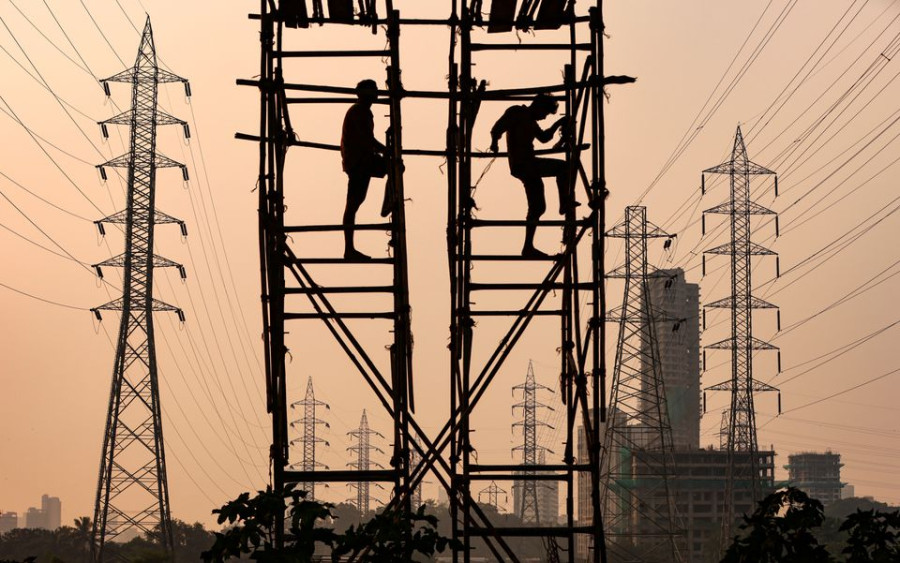National
Nepal starts selling more electricity to India from Saturday midnight
This is the first time that the country is exporting such huge quantity of energy to India.
Prithvi Man Shrestha
The Nepal Electricity Authority started selling an additional 140MW of electricity generated by Kaligandaki A Hydropower Project to India through its power exchange market starting Saturday midnight.
The state owned power utility body first started selling 37.7 MW electricity generated by 24MW Trishuli and 15MW Devighat power plants from Wednesday midnight after
the country’s power plants started to generate surplus energy.
“After the addition of electricity generated from 144MW Kaligandaki Hydropower Project, we will be selling a total of 177.7MW electricity to our southern neighbour through India Energy Exchange Limited (IEX),” Suresh Bhattarai, spokesperson for the NEA, told the Post.
It is the first time that the country is exporting such a large quantity of power through the power exchange market of India.
“Average clearing price of our electricity has been maintained at INR7.04 per unit,” said Bhattarai. In a statement, NEA said that the highest price for Nepal’s electricity has been maintained at INR 12 per unit and the lowest price at INR 1.49 per unit. In IEX, the electricity is traded in 96 blocks each lasting 15 minutes and prices differ on every block.
Nepal is now selling electricity to India through its exchange market for the second year in a row.
The state-owned power utility body had sold electricity from the Trishuli and Devighat power plants for nearly one and a half months starting early November last year.
But Nepal had to import electricity from India with the onset of the dry season in December when water levels in the rivers where hydropower plants are based reduced, decreasing the output of the hydropower plants.
In recent days, frequent rains and snowmelt in the Himalayas increased the water levels on rivers, allowing the power plants to produce more electricity. The Indian authorities have so far allowed the NEA to sell a total of 364 megawatts in the open markets of India from the electricity generated by Marsyangdi (67MW), Madhya Marsyangdi (68MW), Trishuli (22MW), Devighat (14MW), Kaligandaki A (140MW) and Likhu (51MW).
Bhattarai said that the NEA expects to increase exports gradually in the days to come.
In early May, NEA had invited bids from Indian companies to sell its 200MW surplus energy in the rainy season under a long-term power purchase agreement.
The power monopoly said in a statement that it would sell the surplus energy from July 1 to November 29.
All open access consumers, regulated utilities, power distribution companies and traders having valid trading licences issued by the Central Electricity Regulatory Commission of India can participate in the bidding process, according to the notice.
Nepal has been able to export energy to India at a time when its southern neighbour is facing an energy crisis due to the shortage of coal and its skyrocketing prices internationally amid the Russia-Ukraine war.
On the other hand, electricity has also emerged as a credible source of foreign exchange earning at a time when Nepal’s foreign exchange reserves have been decreasing due to surging imports from the beginning of the current fiscal year.
The gross foreign exchange reserves decreased by 18.2 percent to $9.61 billion in mid-April 2022 from $11.75 billion in mid-July 2021, according to Nepal Rastra Bank.
Imports constitute nearly 90 percent of the country’s total international trade, and with Nepal lacking export materials, the balance of payment gap has been huge.
Nepal and India have also agreed to take energy cooperation to newer heights. During Prime Minister Sher Bahadur Deuba’s visit to India in early April, Prime Minister Deuba and his Indian counterpart Narendra Modi agreed on the Joint Vision Statement on Power Sector Cooperation which talks about strengthening cooperation on joint development of power generation projects in Nepal, and development of cross-border transmission infrastructure and bi-directional power trade with appropriate access to electricity markets in both countries based on mutual benefits.




 6.84°C Kathmandu
6.84°C Kathmandu









%20(1).jpg&w=300&height=200)





